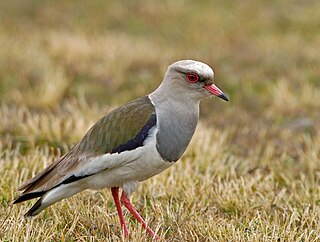
The black-necked swan is a species of waterfowl in the tribe Cygnini of the subfamily Anserinae. It is found in Argentina, Brazil, Chile, Uruguay, and the Falkland Islands.

The coscoroba swan is a species of waterfowl in the subfamily Anserinae of the family Anatidae. It is found in Argentina, Bolivia, Brazil, Chile, Paraguay, Uruguay, and the Falkland Islands.

The Orinoco goose is a Near Threatened species of waterfowl in the tribe Tadornini of subfamily Anserinae. It is found in every mainland South American country except Chile, French Guiana, Suriname, and Uruguay.

The Pantanal snipe is a bird in tribe Scolopancinai and subfamily Scolopacinae of family Scolopacidae, the sandpipers and relatives. It is found on Trinidad and Tobago, the Falkland Islands, and in every mainland South American country

The puna snipe is a bird in tribe Scolopancinai and subfamily Scolopacinae of family Scolopacidae, the sandpipers and relatives. It is found in Argentina, Bolivia, Chile, and Peru.

The puna plover is a species of bird in subfamily Charadriinae of family Charadriidae. It is found in Argentina, Bolivia, Chile, and Peru.

The rufous-chested dotterel or rufous-chested plover, is a species of bird in subfamily Charadriinae of family Charadriidae. It is found in Argentina, Brazil, Chile, Uruguay, and the Falkland Islands.

The tawny-throated dotterel is a species of bird in the family Charadriidae, the plovers and their relatives. It is found in Argentina, Bolivia, Brazil, Chile, Peru, and Uruguay.

The Andean lapwing is a species of bird in family Charadriidae, the plovers and their relatives. It is found in Argentina, Bolivia, Chile, Colombia, Ecuador, and Peru.

The Andean gull is a species in subfamily Larinae of the family Laridae, the gulls, terns, and skimmers. It is found in Argentina, Bolivia, Chile, Colombia, Ecuador, and Peru.

The spot-winged pigeon is a species of bird in the family Columbidae. It is found in Argentina, Bolivia, Brazil, Chile, Paraguay, Peru, and Uruguay.

The black-banded crake is a species of bird in subfamily Rallinae of family Rallidae, the rails, gallinules, and coots. It is found in Brazil, Colombia, Ecuador, and Peru.

The speckled rail, also called speckled crake, is a species of bird in subfamily Rallinae of family Rallidae, the rails, gallinules, and coots. It is found in Argentina, Brazil, Guyana, Paraguay, Uruguay, and Venezuela.

The white-winged coot is a species of bird in subfamily Rallinae of family Rallidae, the rails, gallinules, and coots. It is found in Argentina, Bolivia, Brazil, Chile, Paraguay, Uruguay, and the Falkland Islands.

The plumbeous rail is a species of bird in the subfamily Rallinae of the rail, crake, and coot family Rallidae. It is found in Argentina, Bolivia, Brazil, Chile, Ecuador, Paraguay, Peru and Uruguay.

The ash-throated crake is a species of bird in the subfamily Rallinae of the rail, crake, and coot family Rallidae. It is found in every mainland South American country except Chile.

The austral rail is a Vulnerable species of bird in subfamily Rallinae of family Rallidae, the rails, gallinules, and coots. It is found in Argentina and Chile.

The buff-winged cinclodes is a species of bird in the Furnariinae subfamily of the ovenbird family Furnariidae. It is found in Argentina, Brazil, Chile, Paraguay, Uruguay and as a vagrant on the Falkland Islands.

The white-banded mockingbird is a species of bird in the family Mimidae. It is found in Argentina, Bolivia, Brazil, Chile, Paraguay, and Uruguay.

The Magellanic snipe is a bird in tribe Scolopancinai and subfamily Scolopacinae of family Scolopacidae, the sandpipers and relatives. It is found in Argentina, Chile, Uruguay, and the Falkland Islands.























